Tianjin Port Incident: Risk Management Plan and Damage Analysis
VerifiedAdded on 2023/06/10
|10
|2199
|136
AI Summary
This report analyzes the Tianjin Port Incident of 2015, focusing on the risk management plan and damage analysis. It discusses the principles of risk management, the incident, risks associated, risk management plan, and damage caused.
Contribute Materials
Your contribution can guide someone’s learning journey. Share your
documents today.
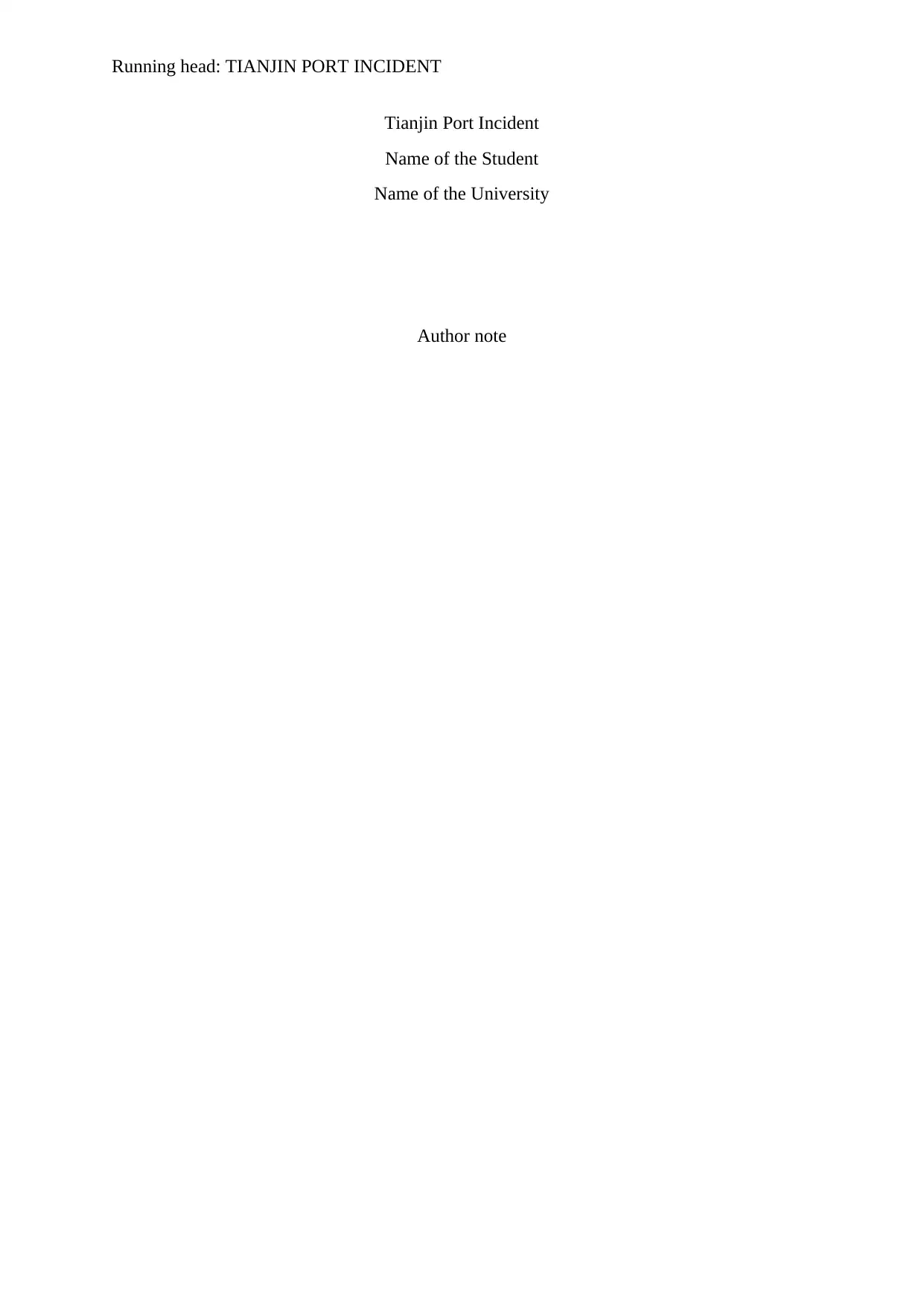
Running head: TIANJIN PORT INCIDENT
Tianjin Port Incident
Name of the Student
Name of the University
Author note
Tianjin Port Incident
Name of the Student
Name of the University
Author note
Secure Best Marks with AI Grader
Need help grading? Try our AI Grader for instant feedback on your assignments.
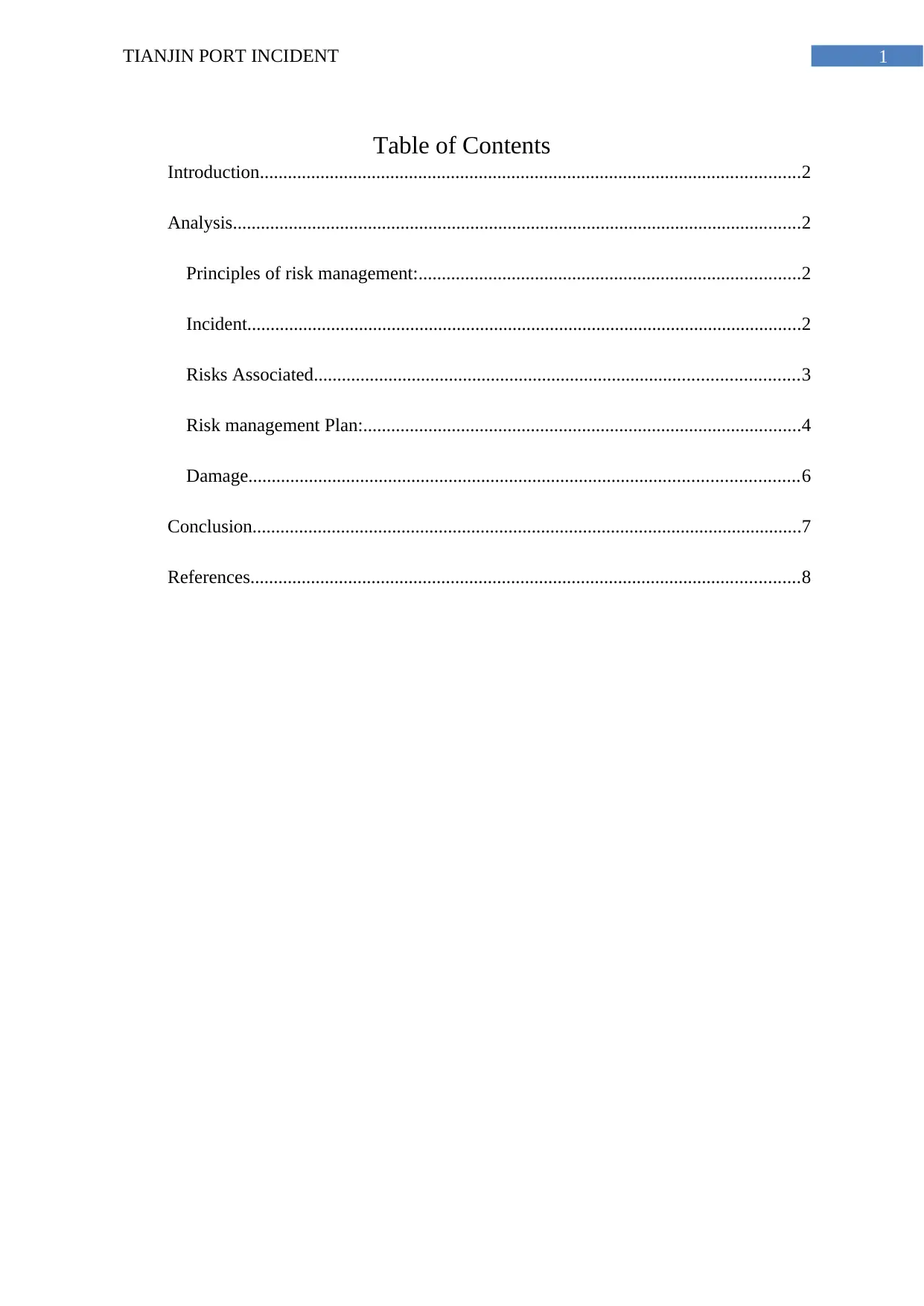
1TIANJIN PORT INCIDENT
Table of Contents
Introduction....................................................................................................................2
Analysis..........................................................................................................................2
Principles of risk management:..................................................................................2
Incident.......................................................................................................................2
Risks Associated........................................................................................................3
Risk management Plan:..............................................................................................4
Damage......................................................................................................................6
Conclusion......................................................................................................................7
References......................................................................................................................8
Table of Contents
Introduction....................................................................................................................2
Analysis..........................................................................................................................2
Principles of risk management:..................................................................................2
Incident.......................................................................................................................2
Risks Associated........................................................................................................3
Risk management Plan:..............................................................................................4
Damage......................................................................................................................6
Conclusion......................................................................................................................7
References......................................................................................................................8
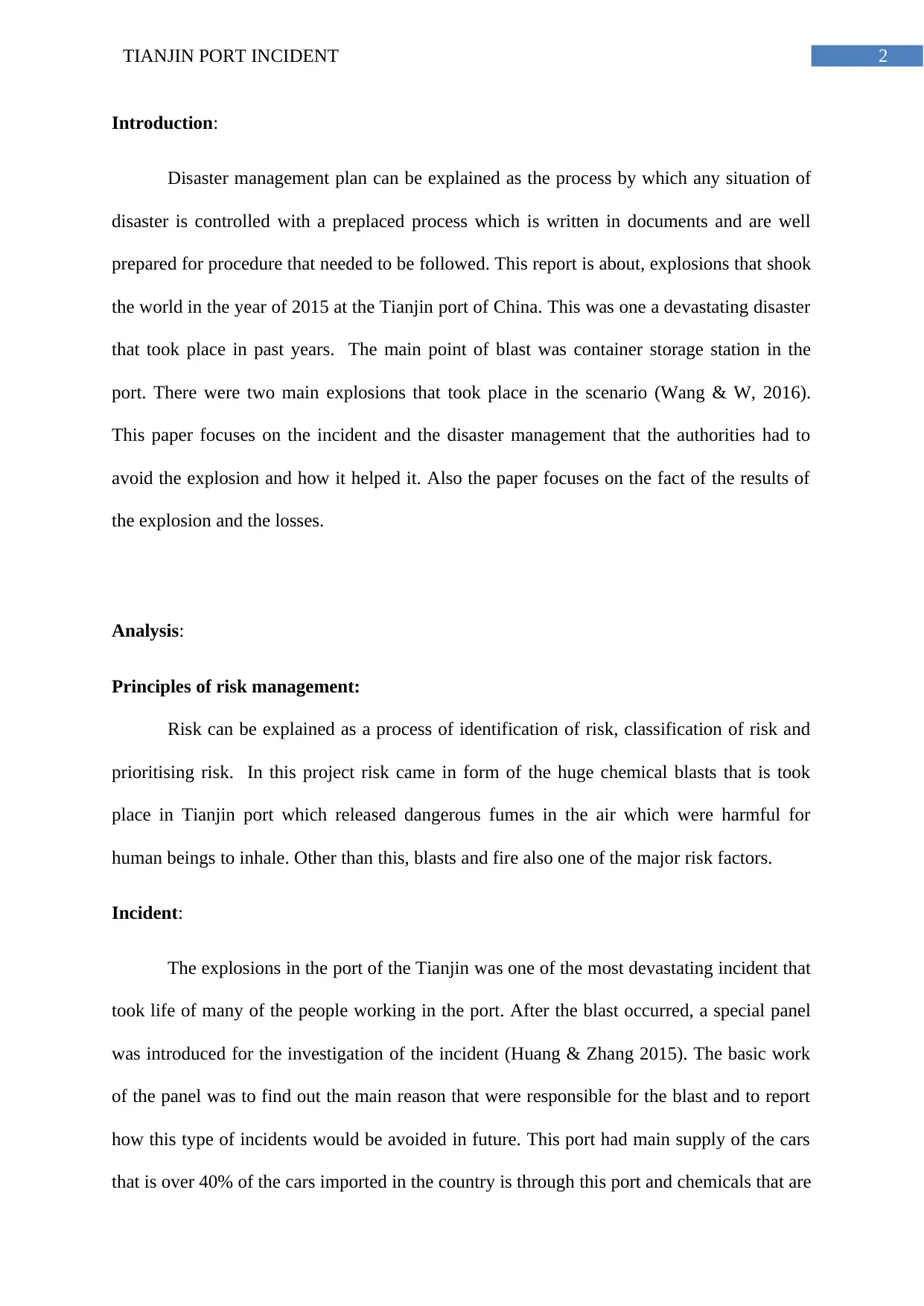
2TIANJIN PORT INCIDENT
Introduction:
Disaster management plan can be explained as the process by which any situation of
disaster is controlled with a preplaced process which is written in documents and are well
prepared for procedure that needed to be followed. This report is about, explosions that shook
the world in the year of 2015 at the Tianjin port of China. This was one a devastating disaster
that took place in past years. The main point of blast was container storage station in the
port. There were two main explosions that took place in the scenario (Wang & W, 2016).
This paper focuses on the incident and the disaster management that the authorities had to
avoid the explosion and how it helped it. Also the paper focuses on the fact of the results of
the explosion and the losses.
Analysis:
Principles of risk management:
Risk can be explained as a process of identification of risk, classification of risk and
prioritising risk. In this project risk came in form of the huge chemical blasts that is took
place in Tianjin port which released dangerous fumes in the air which were harmful for
human beings to inhale. Other than this, blasts and fire also one of the major risk factors.
Incident:
The explosions in the port of the Tianjin was one of the most devastating incident that
took life of many of the people working in the port. After the blast occurred, a special panel
was introduced for the investigation of the incident (Huang & Zhang 2015). The basic work
of the panel was to find out the main reason that were responsible for the blast and to report
how this type of incidents would be avoided in future. This port had main supply of the cars
that is over 40% of the cars imported in the country is through this port and chemicals that are
Introduction:
Disaster management plan can be explained as the process by which any situation of
disaster is controlled with a preplaced process which is written in documents and are well
prepared for procedure that needed to be followed. This report is about, explosions that shook
the world in the year of 2015 at the Tianjin port of China. This was one a devastating disaster
that took place in past years. The main point of blast was container storage station in the
port. There were two main explosions that took place in the scenario (Wang & W, 2016).
This paper focuses on the incident and the disaster management that the authorities had to
avoid the explosion and how it helped it. Also the paper focuses on the fact of the results of
the explosion and the losses.
Analysis:
Principles of risk management:
Risk can be explained as a process of identification of risk, classification of risk and
prioritising risk. In this project risk came in form of the huge chemical blasts that is took
place in Tianjin port which released dangerous fumes in the air which were harmful for
human beings to inhale. Other than this, blasts and fire also one of the major risk factors.
Incident:
The explosions in the port of the Tianjin was one of the most devastating incident that
took life of many of the people working in the port. After the blast occurred, a special panel
was introduced for the investigation of the incident (Huang & Zhang 2015). The basic work
of the panel was to find out the main reason that were responsible for the blast and to report
how this type of incidents would be avoided in future. This port had main supply of the cars
that is over 40% of the cars imported in the country is through this port and chemicals that are
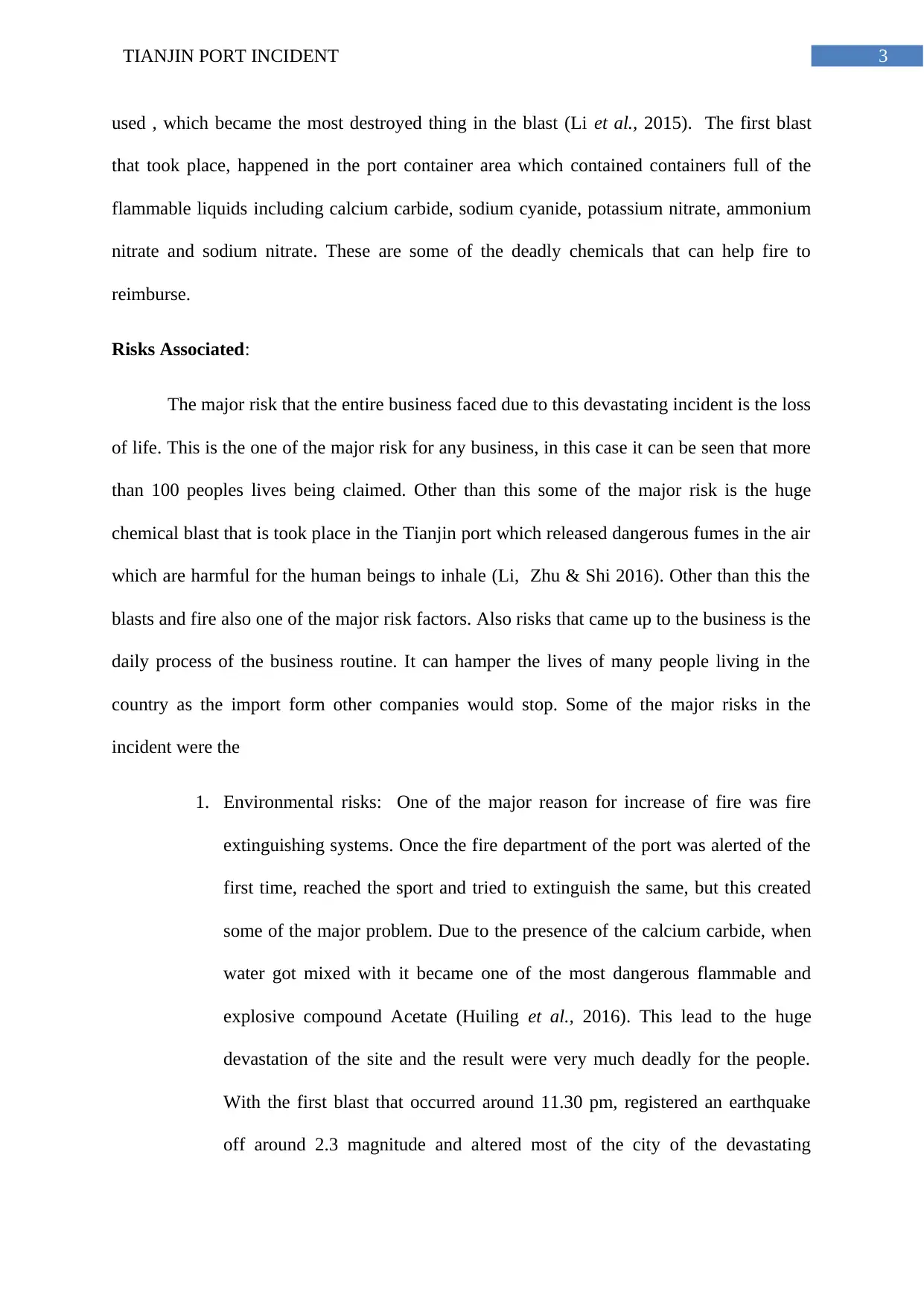
3TIANJIN PORT INCIDENT
used , which became the most destroyed thing in the blast (Li et al., 2015). The first blast
that took place, happened in the port container area which contained containers full of the
flammable liquids including calcium carbide, sodium cyanide, potassium nitrate, ammonium
nitrate and sodium nitrate. These are some of the deadly chemicals that can help fire to
reimburse.
Risks Associated:
The major risk that the entire business faced due to this devastating incident is the loss
of life. This is the one of the major risk for any business, in this case it can be seen that more
than 100 peoples lives being claimed. Other than this some of the major risk is the huge
chemical blast that is took place in the Tianjin port which released dangerous fumes in the air
which are harmful for the human beings to inhale (Li, Zhu & Shi 2016). Other than this the
blasts and fire also one of the major risk factors. Also risks that came up to the business is the
daily process of the business routine. It can hamper the lives of many people living in the
country as the import form other companies would stop. Some of the major risks in the
incident were the
1. Environmental risks: One of the major reason for increase of fire was fire
extinguishing systems. Once the fire department of the port was alerted of the
first time, reached the sport and tried to extinguish the same, but this created
some of the major problem. Due to the presence of the calcium carbide, when
water got mixed with it became one of the most dangerous flammable and
explosive compound Acetate (Huiling et al., 2016). This lead to the huge
devastation of the site and the result were very much deadly for the people.
With the first blast that occurred around 11.30 pm, registered an earthquake
off around 2.3 magnitude and altered most of the city of the devastating
used , which became the most destroyed thing in the blast (Li et al., 2015). The first blast
that took place, happened in the port container area which contained containers full of the
flammable liquids including calcium carbide, sodium cyanide, potassium nitrate, ammonium
nitrate and sodium nitrate. These are some of the deadly chemicals that can help fire to
reimburse.
Risks Associated:
The major risk that the entire business faced due to this devastating incident is the loss
of life. This is the one of the major risk for any business, in this case it can be seen that more
than 100 peoples lives being claimed. Other than this some of the major risk is the huge
chemical blast that is took place in the Tianjin port which released dangerous fumes in the air
which are harmful for the human beings to inhale (Li, Zhu & Shi 2016). Other than this the
blasts and fire also one of the major risk factors. Also risks that came up to the business is the
daily process of the business routine. It can hamper the lives of many people living in the
country as the import form other companies would stop. Some of the major risks in the
incident were the
1. Environmental risks: One of the major reason for increase of fire was fire
extinguishing systems. Once the fire department of the port was alerted of the
first time, reached the sport and tried to extinguish the same, but this created
some of the major problem. Due to the presence of the calcium carbide, when
water got mixed with it became one of the most dangerous flammable and
explosive compound Acetate (Huiling et al., 2016). This lead to the huge
devastation of the site and the result were very much deadly for the people.
With the first blast that occurred around 11.30 pm, registered an earthquake
off around 2.3 magnitude and altered most of the city of the devastating
Secure Best Marks with AI Grader
Need help grading? Try our AI Grader for instant feedback on your assignments.
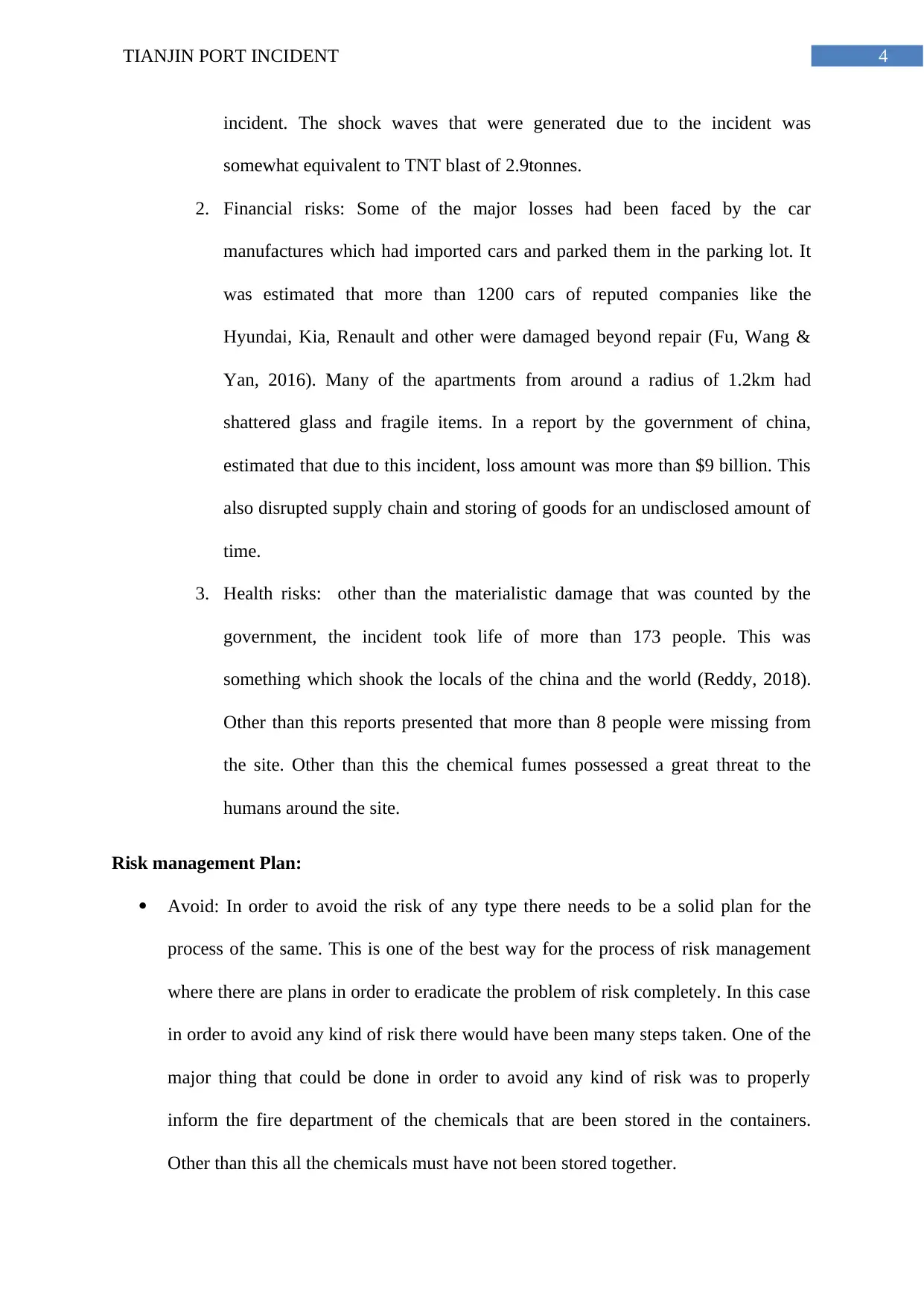
4TIANJIN PORT INCIDENT
incident. The shock waves that were generated due to the incident was
somewhat equivalent to TNT blast of 2.9tonnes.
2. Financial risks: Some of the major losses had been faced by the car
manufactures which had imported cars and parked them in the parking lot. It
was estimated that more than 1200 cars of reputed companies like the
Hyundai, Kia, Renault and other were damaged beyond repair (Fu, Wang &
Yan, 2016). Many of the apartments from around a radius of 1.2km had
shattered glass and fragile items. In a report by the government of china,
estimated that due to this incident, loss amount was more than $9 billion. This
also disrupted supply chain and storing of goods for an undisclosed amount of
time.
3. Health risks: other than the materialistic damage that was counted by the
government, the incident took life of more than 173 people. This was
something which shook the locals of the china and the world (Reddy, 2018).
Other than this reports presented that more than 8 people were missing from
the site. Other than this the chemical fumes possessed a great threat to the
humans around the site.
Risk management Plan:
Avoid: In order to avoid the risk of any type there needs to be a solid plan for the
process of the same. This is one of the best way for the process of risk management
where there are plans in order to eradicate the problem of risk completely. In this case
in order to avoid any kind of risk there would have been many steps taken. One of the
major thing that could be done in order to avoid any kind of risk was to properly
inform the fire department of the chemicals that are been stored in the containers.
Other than this all the chemicals must have not been stored together.
incident. The shock waves that were generated due to the incident was
somewhat equivalent to TNT blast of 2.9tonnes.
2. Financial risks: Some of the major losses had been faced by the car
manufactures which had imported cars and parked them in the parking lot. It
was estimated that more than 1200 cars of reputed companies like the
Hyundai, Kia, Renault and other were damaged beyond repair (Fu, Wang &
Yan, 2016). Many of the apartments from around a radius of 1.2km had
shattered glass and fragile items. In a report by the government of china,
estimated that due to this incident, loss amount was more than $9 billion. This
also disrupted supply chain and storing of goods for an undisclosed amount of
time.
3. Health risks: other than the materialistic damage that was counted by the
government, the incident took life of more than 173 people. This was
something which shook the locals of the china and the world (Reddy, 2018).
Other than this reports presented that more than 8 people were missing from
the site. Other than this the chemical fumes possessed a great threat to the
humans around the site.
Risk management Plan:
Avoid: In order to avoid the risk of any type there needs to be a solid plan for the
process of the same. This is one of the best way for the process of risk management
where there are plans in order to eradicate the problem of risk completely. In this case
in order to avoid any kind of risk there would have been many steps taken. One of the
major thing that could be done in order to avoid any kind of risk was to properly
inform the fire department of the chemicals that are been stored in the containers.
Other than this all the chemicals must have not been stored together.
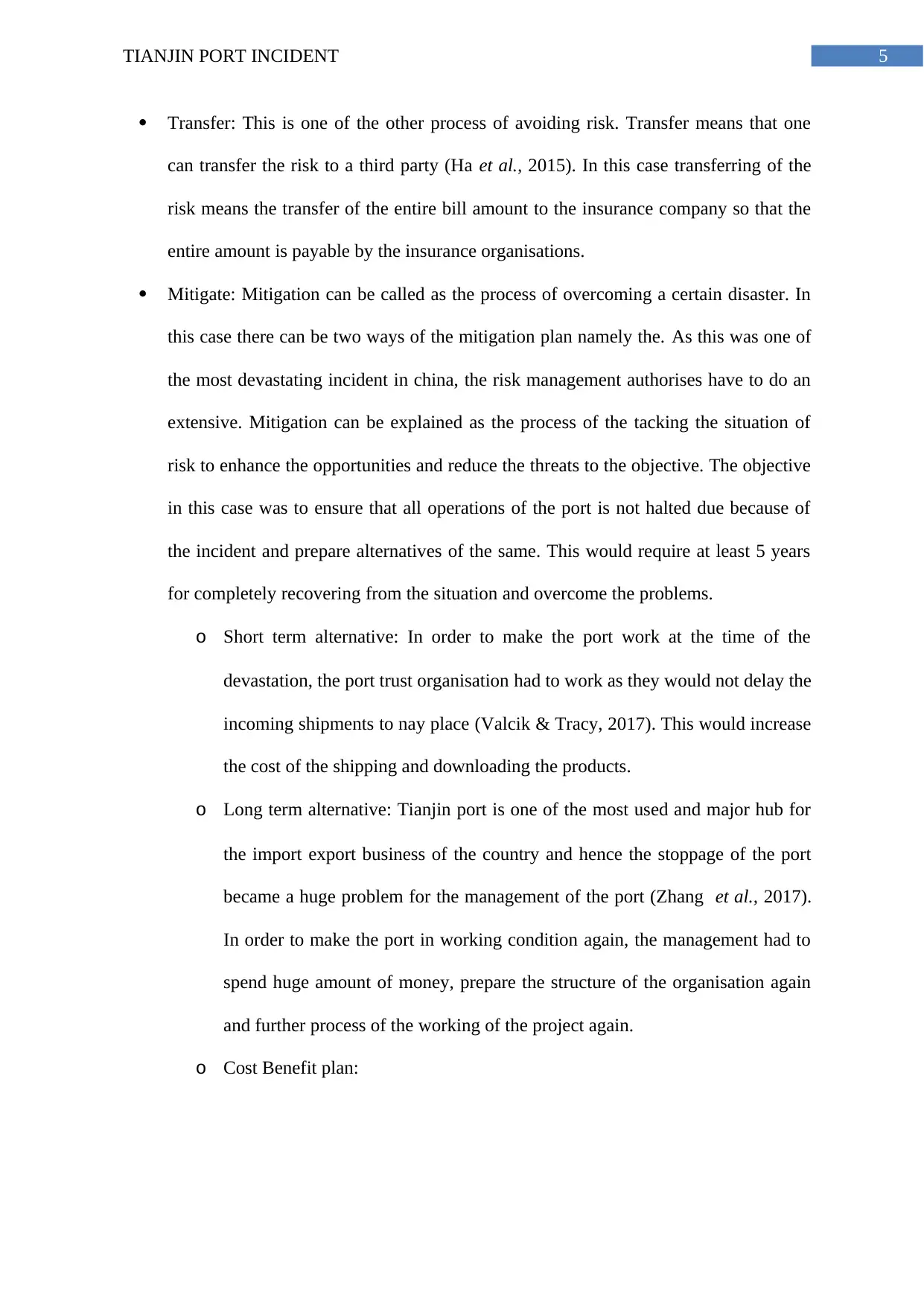
5TIANJIN PORT INCIDENT
Transfer: This is one of the other process of avoiding risk. Transfer means that one
can transfer the risk to a third party (Ha et al., 2015). In this case transferring of the
risk means the transfer of the entire bill amount to the insurance company so that the
entire amount is payable by the insurance organisations.
Mitigate: Mitigation can be called as the process of overcoming a certain disaster. In
this case there can be two ways of the mitigation plan namely the. As this was one of
the most devastating incident in china, the risk management authorises have to do an
extensive. Mitigation can be explained as the process of the tacking the situation of
risk to enhance the opportunities and reduce the threats to the objective. The objective
in this case was to ensure that all operations of the port is not halted due because of
the incident and prepare alternatives of the same. This would require at least 5 years
for completely recovering from the situation and overcome the problems.
o Short term alternative: In order to make the port work at the time of the
devastation, the port trust organisation had to work as they would not delay the
incoming shipments to nay place (Valcik & Tracy, 2017). This would increase
the cost of the shipping and downloading the products.
o Long term alternative: Tianjin port is one of the most used and major hub for
the import export business of the country and hence the stoppage of the port
became a huge problem for the management of the port (Zhang et al., 2017).
In order to make the port in working condition again, the management had to
spend huge amount of money, prepare the structure of the organisation again
and further process of the working of the project again.
o Cost Benefit plan:
Transfer: This is one of the other process of avoiding risk. Transfer means that one
can transfer the risk to a third party (Ha et al., 2015). In this case transferring of the
risk means the transfer of the entire bill amount to the insurance company so that the
entire amount is payable by the insurance organisations.
Mitigate: Mitigation can be called as the process of overcoming a certain disaster. In
this case there can be two ways of the mitigation plan namely the. As this was one of
the most devastating incident in china, the risk management authorises have to do an
extensive. Mitigation can be explained as the process of the tacking the situation of
risk to enhance the opportunities and reduce the threats to the objective. The objective
in this case was to ensure that all operations of the port is not halted due because of
the incident and prepare alternatives of the same. This would require at least 5 years
for completely recovering from the situation and overcome the problems.
o Short term alternative: In order to make the port work at the time of the
devastation, the port trust organisation had to work as they would not delay the
incoming shipments to nay place (Valcik & Tracy, 2017). This would increase
the cost of the shipping and downloading the products.
o Long term alternative: Tianjin port is one of the most used and major hub for
the import export business of the country and hence the stoppage of the port
became a huge problem for the management of the port (Zhang et al., 2017).
In order to make the port in working condition again, the management had to
spend huge amount of money, prepare the structure of the organisation again
and further process of the working of the project again.
o Cost Benefit plan:
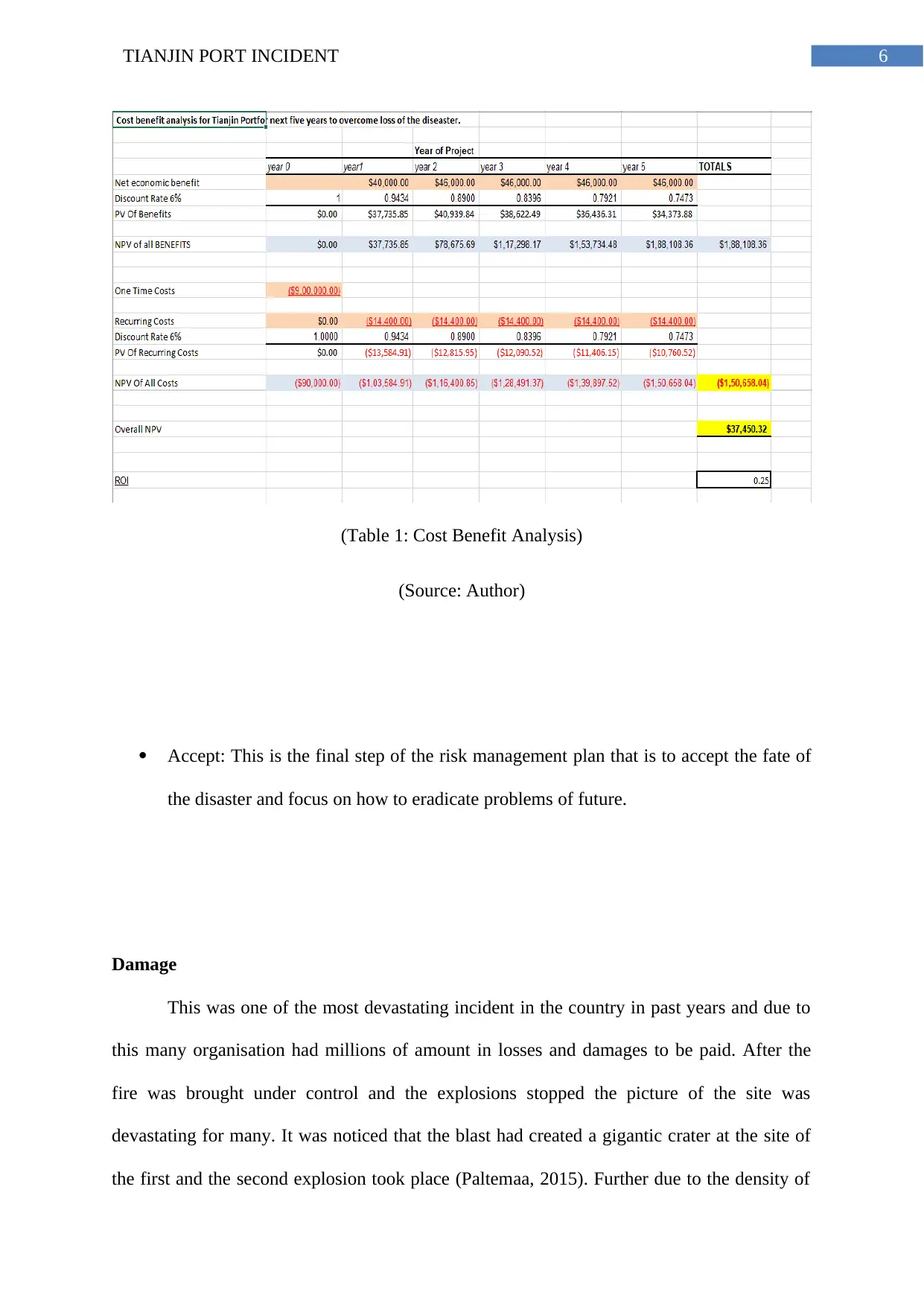
6TIANJIN PORT INCIDENT
(Table 1: Cost Benefit Analysis)
(Source: Author)
Accept: This is the final step of the risk management plan that is to accept the fate of
the disaster and focus on how to eradicate problems of future.
Damage
This was one of the most devastating incident in the country in past years and due to
this many organisation had millions of amount in losses and damages to be paid. After the
fire was brought under control and the explosions stopped the picture of the site was
devastating for many. It was noticed that the blast had created a gigantic crater at the site of
the first and the second explosion took place (Paltemaa, 2015). Further due to the density of
(Table 1: Cost Benefit Analysis)
(Source: Author)
Accept: This is the final step of the risk management plan that is to accept the fate of
the disaster and focus on how to eradicate problems of future.
Damage
This was one of the most devastating incident in the country in past years and due to
this many organisation had millions of amount in losses and damages to be paid. After the
fire was brought under control and the explosions stopped the picture of the site was
devastating for many. It was noticed that the blast had created a gigantic crater at the site of
the first and the second explosion took place (Paltemaa, 2015). Further due to the density of
Paraphrase This Document
Need a fresh take? Get an instant paraphrase of this document with our AI Paraphraser
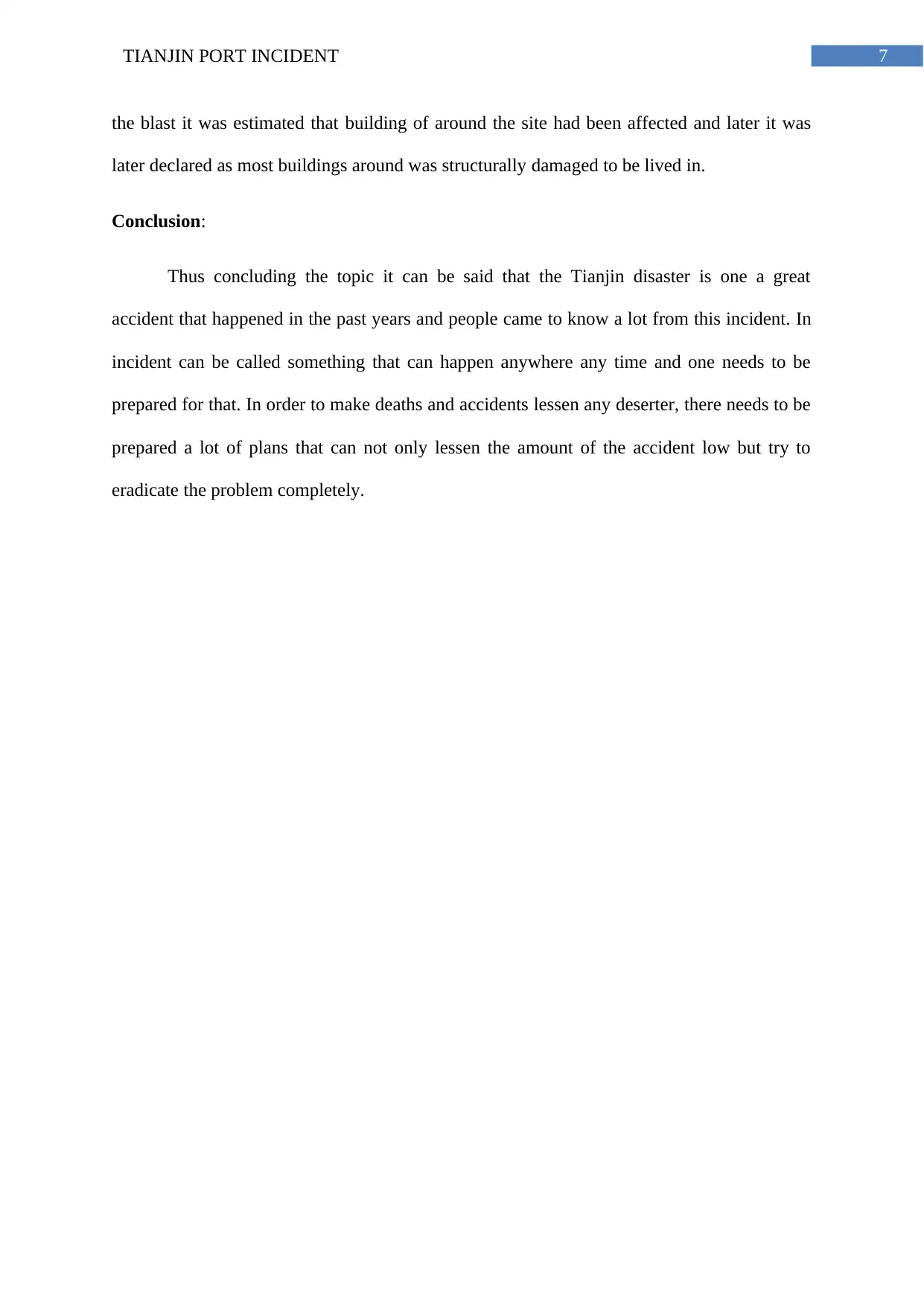
7TIANJIN PORT INCIDENT
the blast it was estimated that building of around the site had been affected and later it was
later declared as most buildings around was structurally damaged to be lived in.
Conclusion:
Thus concluding the topic it can be said that the Tianjin disaster is one a great
accident that happened in the past years and people came to know a lot from this incident. In
incident can be called something that can happen anywhere any time and one needs to be
prepared for that. In order to make deaths and accidents lessen any deserter, there needs to be
prepared a lot of plans that can not only lessen the amount of the accident low but try to
eradicate the problem completely.
the blast it was estimated that building of around the site had been affected and later it was
later declared as most buildings around was structurally damaged to be lived in.
Conclusion:
Thus concluding the topic it can be said that the Tianjin disaster is one a great
accident that happened in the past years and people came to know a lot from this incident. In
incident can be called something that can happen anywhere any time and one needs to be
prepared for that. In order to make deaths and accidents lessen any deserter, there needs to be
prepared a lot of plans that can not only lessen the amount of the accident low but try to
eradicate the problem completely.
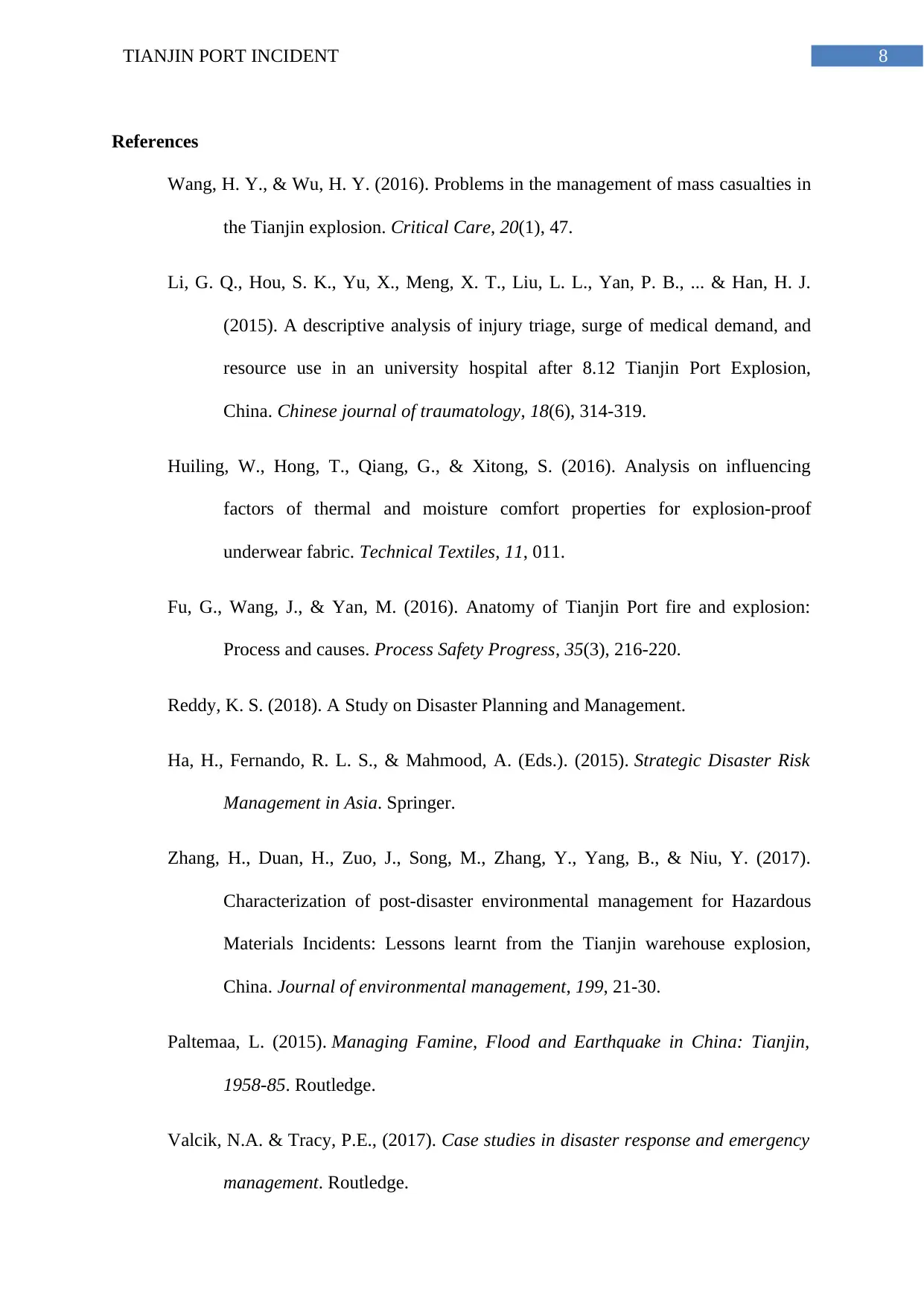
8TIANJIN PORT INCIDENT
References
Wang, H. Y., & Wu, H. Y. (2016). Problems in the management of mass casualties in
the Tianjin explosion. Critical Care, 20(1), 47.
Li, G. Q., Hou, S. K., Yu, X., Meng, X. T., Liu, L. L., Yan, P. B., ... & Han, H. J.
(2015). A descriptive analysis of injury triage, surge of medical demand, and
resource use in an university hospital after 8.12 Tianjin Port Explosion,
China. Chinese journal of traumatology, 18(6), 314-319.
Huiling, W., Hong, T., Qiang, G., & Xitong, S. (2016). Analysis on influencing
factors of thermal and moisture comfort properties for explosion-proof
underwear fabric. Technical Textiles, 11, 011.
Fu, G., Wang, J., & Yan, M. (2016). Anatomy of Tianjin Port fire and explosion:
Process and causes. Process Safety Progress, 35(3), 216-220.
Reddy, K. S. (2018). A Study on Disaster Planning and Management.
Ha, H., Fernando, R. L. S., & Mahmood, A. (Eds.). (2015). Strategic Disaster Risk
Management in Asia. Springer.
Zhang, H., Duan, H., Zuo, J., Song, M., Zhang, Y., Yang, B., & Niu, Y. (2017).
Characterization of post-disaster environmental management for Hazardous
Materials Incidents: Lessons learnt from the Tianjin warehouse explosion,
China. Journal of environmental management, 199, 21-30.
Paltemaa, L. (2015). Managing Famine, Flood and Earthquake in China: Tianjin,
1958-85. Routledge.
Valcik, N.A. & Tracy, P.E., (2017). Case studies in disaster response and emergency
management. Routledge.
References
Wang, H. Y., & Wu, H. Y. (2016). Problems in the management of mass casualties in
the Tianjin explosion. Critical Care, 20(1), 47.
Li, G. Q., Hou, S. K., Yu, X., Meng, X. T., Liu, L. L., Yan, P. B., ... & Han, H. J.
(2015). A descriptive analysis of injury triage, surge of medical demand, and
resource use in an university hospital after 8.12 Tianjin Port Explosion,
China. Chinese journal of traumatology, 18(6), 314-319.
Huiling, W., Hong, T., Qiang, G., & Xitong, S. (2016). Analysis on influencing
factors of thermal and moisture comfort properties for explosion-proof
underwear fabric. Technical Textiles, 11, 011.
Fu, G., Wang, J., & Yan, M. (2016). Anatomy of Tianjin Port fire and explosion:
Process and causes. Process Safety Progress, 35(3), 216-220.
Reddy, K. S. (2018). A Study on Disaster Planning and Management.
Ha, H., Fernando, R. L. S., & Mahmood, A. (Eds.). (2015). Strategic Disaster Risk
Management in Asia. Springer.
Zhang, H., Duan, H., Zuo, J., Song, M., Zhang, Y., Yang, B., & Niu, Y. (2017).
Characterization of post-disaster environmental management for Hazardous
Materials Incidents: Lessons learnt from the Tianjin warehouse explosion,
China. Journal of environmental management, 199, 21-30.
Paltemaa, L. (2015). Managing Famine, Flood and Earthquake in China: Tianjin,
1958-85. Routledge.
Valcik, N.A. & Tracy, P.E., (2017). Case studies in disaster response and emergency
management. Routledge.
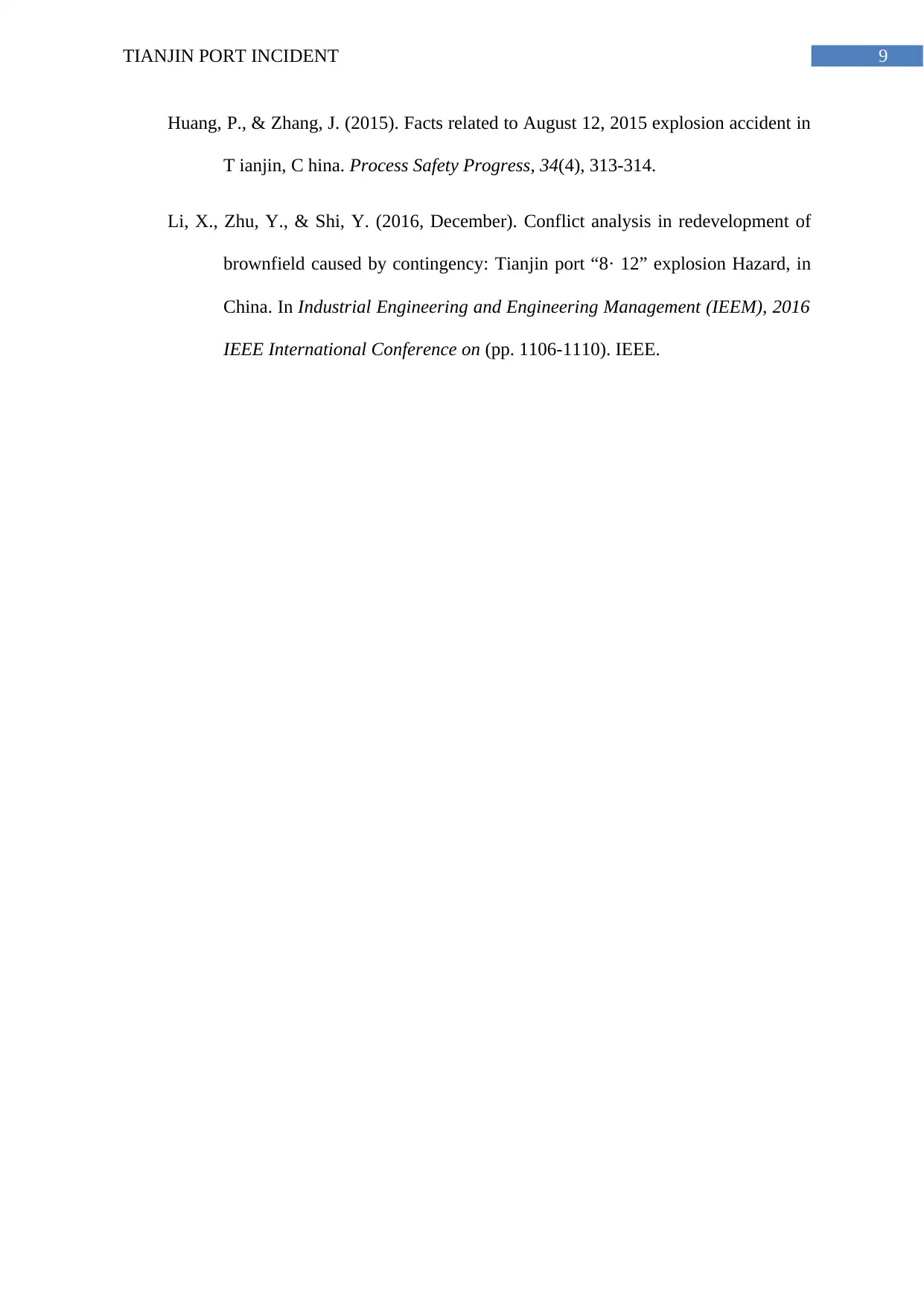
9TIANJIN PORT INCIDENT
Huang, P., & Zhang, J. (2015). Facts related to August 12, 2015 explosion accident in
T ianjin, C hina. Process Safety Progress, 34(4), 313-314.
Li, X., Zhu, Y., & Shi, Y. (2016, December). Conflict analysis in redevelopment of
brownfield caused by contingency: Tianjin port “8· 12” explosion Hazard, in
China. In Industrial Engineering and Engineering Management (IEEM), 2016
IEEE International Conference on (pp. 1106-1110). IEEE.
Huang, P., & Zhang, J. (2015). Facts related to August 12, 2015 explosion accident in
T ianjin, C hina. Process Safety Progress, 34(4), 313-314.
Li, X., Zhu, Y., & Shi, Y. (2016, December). Conflict analysis in redevelopment of
brownfield caused by contingency: Tianjin port “8· 12” explosion Hazard, in
China. In Industrial Engineering and Engineering Management (IEEM), 2016
IEEE International Conference on (pp. 1106-1110). IEEE.
1 out of 10
Related Documents
Your All-in-One AI-Powered Toolkit for Academic Success.
+13062052269
info@desklib.com
Available 24*7 on WhatsApp / Email
![[object Object]](/_next/static/media/star-bottom.7253800d.svg)
Unlock your academic potential
© 2024 | Zucol Services PVT LTD | All rights reserved.




